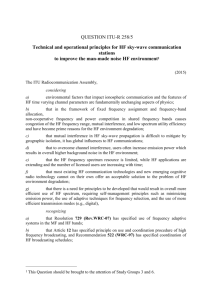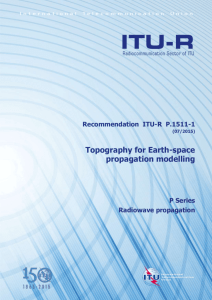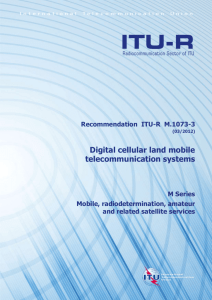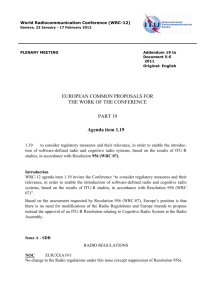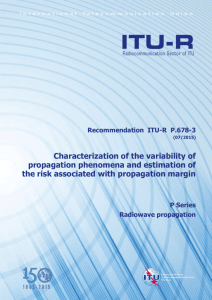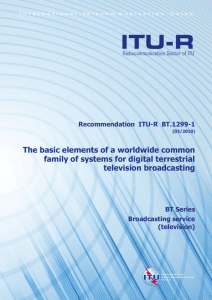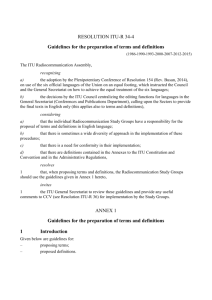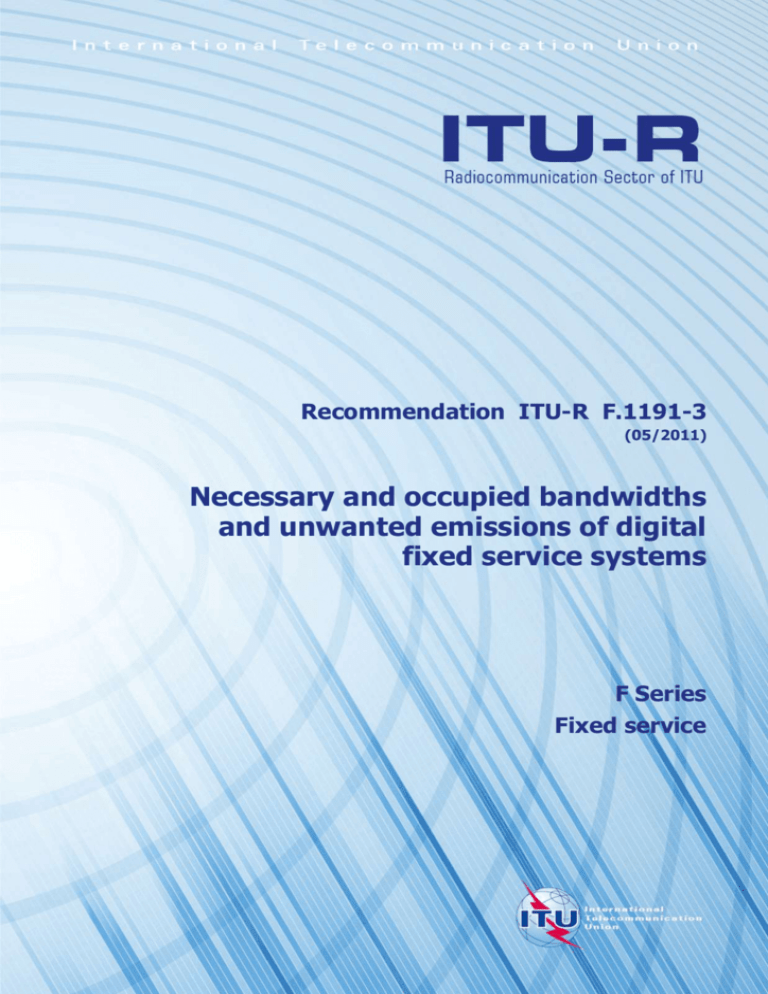
Recommendation ITU-R F.1191-3
(05/2011)
Necessary and occupied bandwidths
and unwanted emissions of digital
fixed service systems
F Series
Fixed service
ii
Rec. ITU-R F.1191-3
Foreword
The role of the Radiocommunication Sector is to ensure the rational, equitable, efficient and economical use of the
radio-frequency spectrum by all radiocommunication services, including satellite services, and carry out studies without
limit of frequency range on the basis of which Recommendations are adopted.
The regulatory and policy functions of the Radiocommunication Sector are performed by World and Regional
Radiocommunication Conferences and Radiocommunication Assemblies supported by Study Groups.
Policy on Intellectual Property Right (IPR)
ITU-R policy on IPR is described in the Common Patent Policy for ITU-T/ITU-R/ISO/IEC referenced in Annex 1 of
Resolution ITU-R 1. Forms to be used for the submission of patent statements and licensing declarations by patent
holders are available from http://www.itu.int/ITU-R/go/patents/en where the Guidelines for Implementation of the
Common Patent Policy for ITU-T/ITU-R/ISO/IEC and the ITU-R patent information database can also be found.
Series of ITU-R Recommendations
(Also available online at http://www.itu.int/publ/R-REC/en)
Series
BO
BR
BS
BT
F
M
P
RA
RS
S
SA
SF
SM
SNG
TF
V
Title
Satellite delivery
Recording for production, archival and play-out; film for television
Broadcasting service (sound)
Broadcasting service (television)
Fixed service
Mobile, radiodetermination, amateur and related satellite services
Radiowave propagation
Radio astronomy
Remote sensing systems
Fixed-satellite service
Space applications and meteorology
Frequency sharing and coordination between fixed-satellite and fixed service systems
Spectrum management
Satellite news gathering
Time signals and frequency standards emissions
Vocabulary and related subjects
Note: This ITU-R Recommendation was approved in English under the procedure detailed in Resolution ITU-R 1.
Electronic Publication
Geneva, 2011
ITU 2011
All rights reserved. No part of this publication may be reproduced, by any means whatsoever, without written permission of ITU.
Rec. ITU-R F.1191-3
1
RECOMMENDATION ITU-R F.1191-3*
Necessary and occupied bandwidths and unwanted emissions
of digital fixed service systems
(1995-1997-2001-2011)
Scope
This Recommendation gives an explanation of basic terms relating to unwanted emissions and
bandwidths of digital fixed service systems to clarify the application of definitions in the Radio
Regulations and Recommendations ITU-R SM.328 and ITU-R SM.329, as well as guidance
consideration on these subjects for use for system or equipment designer of fixed service systems.
Considerations are also made on the occupied bandwidth of multi-carrier systems and requirements
for out-of-band emissions for systems used in the block-based assignment.
The ITU Radiocommunication Assembly,
considering
a)
that it is necessary for designers of digital fixed service systems (DFSS) to give guidance
for the application of the terms relating to bandwidths and unwanted emissions;
b)
that it is relatively unlikely that out-of-band (OoB) emissions from DFSS will cause
significant interference into systems operating in adjacent bands, because:
–
the power spectrum of a DFSS decays rapidly outside the occupied bandwidth;
–
the e.i.r.p. of line-of-sight DFSS is low or medium;
–
trans-horizon DFSS employing a high e.i.r.p. are not widely used;
c)
that from the viewpoint of interference into other systems sharing the same frequency band,
interference due to OoB emissions will be, in general, less significant than that due to emissions
within the necessary bandwidth;
d)
that intra-system interference related problems, which may be caused by unwanted
emissions, are normally taken into account by DFSS designers;
e)
that at the allocated band edges, RF band edge guardband ZS, as defined in
Recommendation ITU-R F.746, is given by the relevant ITU-R Recommendations in order to
control power spill-over into adjacent allocated bands;
f)
that it is not always possible or convenient to make the occupied bandwidth of DFSS
smaller than or equal to the bandwidth of the RF channel provided by the relevant RF channel
arrangement established for the allocated band by ITU-R or by a national regulatory authority;
g)
that in most bands allocated to fixed services on a primary basis, a radio-frequency (RF)
channel arrangement is usually established by a relevant ITU-R Recommendation or by a national
regulatory authority;
*
This Recommendation should be brought to the attention of Radiocommunication Study Group 1.
2
Rec. ITU-R F.1191-3
h)
that, within the allocated band, coordination between various fixed service systems, based
on the use of a RF channel arrangement, is covered by a spectrum-efficient concept summarized by
Recommendation ITU-R F.746 and by the statistical propagation behaviour reported in
Recommendation ITU-R P.530 and Recommendation ITU-R F.1093;
j)
that DFSS, with suitable scrambling applied, have in general a transmitted spectral density
and unwanted emissions with power peak factors that may be conservatively considered noise-like;
k)
that DFSS generate unwanted emissions, composed of both noise-like and discrete
components, in both out-of-band and spurious emissions domains;
l)
that single or multi-carrier systems are widely used in DFSS,
noting
a)
that Recommendation ITU-R SM.328 gives information on the evaluation of OoB spectral
emission for various modulation formats;
b)
that Recommendation ITU-R SM.329 gives the limits and the reference bandwidth for
unwanted emissions in the spurious domain of all services, including the fixed service;
c)
that Recommendation ITU-R SM.1541 gives generic limits for unwanted emissions in the
OoB domain for most of the services, including the fixed service (see Note 1);
d)
that Recommendation ITU-R SM.1539 gives guidance on the variation of the boundary
between OoB and spurious domains for very narrow-band and very wideband emissions,
recommends
1
that the following terms should be applied to DFSS:
1.1
Allocated frequency band
For DFSS the allocated frequency band may be considered as the overall frequency band allocated
to the fixed service on a primary or co-primary basis.
1.2
Assigned frequency band
For the purpose of this Recommendation this term may be considered to apply also to a block of
spectrum assigned to one or more stations of an operator under a single exclusive licence (blockassignment, see examples in Recommendations ITU-R F.1488, ITU-R F.748 and ITU-R F.749).
Inside a single block-assignment, the system designer may, in general, subdivide the block into
suitable smaller sub-blocks in order to deploy a radio network in the geographical area where the
assignment has been made, within conditions specified above (see Recommendation
ITU-R F.1399).
1.3
Radio-frequency channel separation
Bandwidth equal to the frequency separation, defined in Recommendation ITU-R F.746, of adjacent
channels of the relevant RF channel arrangement established within the allocated frequency band.
1.4
Guardband
Bandwidth equal to the frequency separation, defined in Recommendation ITU-R F.746 as ZS,
between the nominal centre frequency of the outermost channel of a RF channel arrangement and
the limit of the allocated band.
Rec. ITU-R F.1191-3
1.5
3
Multicarrier system
Systems where multiple sub-carriers may be transmitted simultaneously from a final output
amplifier or an active antenna within an assigned channel of the relevant channel arrangement or a
specifically dedicated spectrum slot;
2
that the following specific design objectives and terms should be used for DFSS;
an illustration of those objectives and definitions can be found in Fig. 1;
2.1
that, for DFSS, the value of percentage /2 should be taken as 0.5%; this percentage is
assumed for single carrier transmitters; when multicarrier systems are concerned, this percentage,
with respect to the total power of the whole set of sub-carriers should be reduced as a function of
the sub-carriers number and bandwidth (see § 3 of Annex 1 for details);
2.2
that, for DFSS, the necessary bandwidth should be considered to have the same value as the
occupied bandwidth;
2.3
that, according to the type of the utilized RF channel arrangement (see Note 2), the capacity
and the modulation format of the transmitted signal, similar DFSS may have a necessary bandwidth
which is no more than 20% wider than the radio-frequency channel separation (see Note 2);
however, since dissimilar systems operating in the same band may give rise to certain
incompatibilities, the relationship between the RF channel separation and the necessary bandwidth
requires further study;
2.4
that the determination of occupied bandwidth should be done with a spectrum analyser
method described in Recommendation ITU-R SM.328 or, whenever possible, by numerical
evaluation or integration of the actual emitted spectrum as reported in Annex 1;
2.5
that when burst transmission is used (e.g. for time-division multiple access (TDMA) DFSS)
the evaluation of bandwidths and emissions should be done averaging the power over burst
duration;
2.6
that DFSS should use suitable scrambling circuitry in order to maintain all the spectral
emissions (both wanted and unwanted) independent from the input data stream;
2.7
that any unwanted emission which falls at frequencies separated from the centre frequency
of the RF channel by less than 250% of the relevant channel separation, where the system is
intended to be used, should generally be considered unwanted emission in the OoB domain (see
Note 4); when DFSS is intended for use in a frequency band where an RF channel arrangement has
not been established, the necessary bandwidth should be used, instead of channel separation, in
evaluating the 250% boundary;
2.8
that any unwanted emission which falls at frequencies separated from the centre frequency
of the RF channel by 250% or more of the relevant channel separation, where the system is intended
to be used, should generally be considered unwanted emission in the spurious domain (see Note 4);
when DFSS is intended for use in a frequency band where an RF channel arrangement has not been
established, the necessary bandwidth should be used, instead of channel separation, in evaluating
the 250% boundary;
2.9
that, above and below the limits of the necessary bandwidth, the permissible mean power
level of unwanted emission should be less than or equal to 0.5% of the total transmitted mean power
taken at the radio antenna port (see Note 3); in case of multicarrier systems this rule is intended to
be applied to the outermost sub-carriers;
2.10
that, from the viewpoint of the international regulations, it may not be necessary to
establish any additional limitation on the spectral shape of unwanted emissions from DFSS;
4
Rec. ITU-R F.1191-3
2.11
that the levels of spurious emissions, the frequency range for their measurement and the
reference bandwidth in which levels are specified should be those defined by Recommendation
ITU-R SM.329 (see Note 4). Where exclusive block assignments are made, transmitters operating
on sub-channels devised by the licensed operator may, in principle, be exempted, within the block,
by the unwanted emissions limit required to be met outside the block; however at country borders
this should require agreement between the administration concerned due to the fact that they may
have licensed the band in a different way;
2.12
that any safety net limits for unwanted emissions in the OoB domain developed by ITU-R
should be considered as an absolute worst-case limit to which any new DFSS design should
conform;
2.13
that, without other specific agreement between administrations sharing the same band edge,
the digital fixed radio transmitters operating on the outermost channel frequencies of a RF channel
arrangement should have an occupied bandwidth so that the outermost part of it with respect to the
centre frequency of the channel, when added to the absolute value of the frequency tolerance (see
Note 5), results in a bandwidth smaller than or equal to the value of ZS as defined in § 1.4.
NOTE 1 – In general terms the generic limit is considered to be a generally worst-case envelope
based on the least restrictive OoB emission limits successfully used as national or regional
regulations in areas having a high radiocommunication density and representing a significant
portion of the radiocommunication manufacturing base. The word “generally” is intended to cover
exceptional cases where a particularly unrestrictive mask may have been used, e.g. to encourage
equipment development in an unattractive band (see noting c)).
2.14
that the following Notes 2 to 5 should be considered as part of this Recommendation.
NOTE 2 – See Recommendation ITU-R F.746 for definitions of alternated, co-channel mode band
reuse and interleaved mode band reuse RF channel arrangements. Channel separation is defined as
XS/2 for alternated frequency channel arrangements and XS for co-channel and interleaved
frequency channel arrangements.
NOTE 3 – Due to possible compatibility problems, caution should be exercised when applying this
Recommendation to high capacity systems, bands which have dissimilar systems in adjacent
channels, and bands which are shared with other services.
NOTE 4 – Recommendation ITU-R SM.1539 also gives guidance on boundary variations where
very narrow-band or very wideband emissions are concerned. In addition, as Recommendation
ITU-R SM.329 allows for boundary values different than 250%, the following is provisionally
recommended for DFSS operating above 1 GHz with channel separation less than 2 MHz:
–
–
that the boundary between the spurious and out-of-band emissions is established as 500%
of the channel separation;
that the reference bandwidth is 100 kHz in the frequency range between this boundary and
20 MHz of the nominal centre frequency;
and also for DFSS operating above 1 GHz with transmitter power 20 W or more and with channel
separation between 2 MHz and 14 MHz:
–
–
that the boundary between the spurious and OoB emissions is established as 250% of the
channel separation;
that the reference bandwidth is 100 kHz in the frequency range between this boundary and
70 MHz of the nominal centre frequency.
NOTE 5 – The precise frequency tolerance values are left to the national regulatory authorities.
Rec. ITU-R F.1191-3
5
FIGURE 1
Unwanted emission attenuation objectives and bandwidth of DFSS
Occupied semi-bandwidth
of outermost transmitter +
1 ´ frequency tolerance
Necessary bandwidth
i.e. 99% of total
mean power
Limits reported in
recommends 2.11
£ 0.5% of
total mean power
Unwanted emissions
£ 0.5% of
total mean power
RF channel
250% of RF channel separation
250% of RF channel separation
Nominal centre
frequency
End of the band allocated
to the fixed service
Unwanted emissions
Limits reported in
recommends 2.11
RF channel
ZS
Nominal centre
frequency
End of the band allocated
to the fixed service
6
Rec. ITU-R F.1191-3
Annex 1
1
Typical emission scenario of a DFSS
Figure 2 shows the typical scenario based on typical and most important emissions of a heterodyne
digital radio transmitter. Other emissions (e.g. other conversion products and residual components
of the carrier generation) are not shown. For directly modulated RF transmitters, some unwanted
emissions (e.g. conversion products and local oscillator leakage) are not applicable.
FIGURE 2
Frequency bands and unwanted emissions of a DFFS (typical scenario)
Adjacent RF channels
RF channel
separation
Guardband
n-th clock lines
(Note 2)
IF 2nd harmonic
(conversion product)
(Note 1)
Adjacent
allocated band
3rd order
intermodulation
product
(Notes 1 and 3)
n-th harmonic of the wanted signal
(Note 1)
and of the local oscillator
(Note 2)
Local oscillator
leakage
(Note 2)
Image signal
(conversion
product)
(Note 1)
Band allocated to FS with
established channel arrangements
Adjacent
allocated band
Non-adjacent
allocated band
Note 1 – Example of noise-like component of unwanted emissions.
Note 2 – Example of discrete component of unwanted emissions.
Note 3 – Non-linearity due to transmitter results in out-of-band emission which is immediately adjacent
to the necessary bandwidth, due to odd order intermodulation products.
Rec. ITU-R F.1191-3
2
7
Calculation of occupied bandwidth
Generally, a normalized power spectrum W( f ) of a modulated carrier of a DFSS can be expressed
as follows:
sin ( π f T )
W ( f ) S ( f )
πfT
2
(1)
where:
S( f ) :
f:
T:
frequency response of the shaping filter located in the transmitter
frequency separation from the carrier
pulse width.
Therefore, the occupied bandwidth, B0, can be calculated as follows:
B0 / 2
W ( f ) df
(2)
B0 / 2
2.1
W ( f ) df 0.99
Case of phase and amplitude modulated signals with ideal square root cosine roll-off
shaping
In many cases shaping filters of a square root cosine roll-off type are employed at the transmitter
side and the ideal frequency response is given by:
π f T 2
sin ( π f T )
S ( f ) 1 1 sin π T
2
0
f £
for
1
f
2 T
πfT
sin (π f T )
2
1
2T
for
1
1
f £
2T
2T
for
1
£ f
2T
(3)
where is the roll-off factor between 0 and 1.
Substitution of equation (3) into equations (1) and (2) gives the ideal occupied bandwidth as
follows:
B0 2 K () / T
where K() is a function of and is calculated as shown in Table 1.
Thus, the occupied bandwidth can be calculated by using equation (4) and Table 1.
(4)
8
Rec. ITU-R F.1191-3
TABLE 1
The values of K()
2.2
K()
0.1
0.510
0.2
0.537
0.3
0.567
0.4
0.600
0.5
0.634
0.6
0.669
0.7
0.705
0.8
0.742
0.9
0.779
1.0
0.816
Case of phase and amplitude modulated signals with other shaping filters
Different practical implementations and other types of shaping filters are sometimes used. These
cases need more complex numerical evaluations of equation (2) and are under study.
2.3
Case of frequency and phase modulated signals
These cases are under study.
3
Occupied bandwidth for multiple sub-carriers operation
3.1
Case of homogeneous and equally spaced sub-carriers
In some cases, a DFSS transmitter may carry multiple independently modulated sub-carriers
amplified by a common amplifier or an active antenna. They are also commonly referred to as
multicarrier systems (see Note 1).
The occupied bandwidth B0 for such operation should be calculated as follows:
B0 = b0 + (m – 1) F
(5)
where:
b0 :
m:
F :
occupied bandwidth of a single sub-carrier
number of sub-carriers
frequency spacing between centre frequencies of adjacent sub-carriers.
Equation (5) assumes that the multiple sub-carriers are homogeneous and equally spaced and the
transmitter noise is negligible in comparison to the OoB power of the outermost sub-carriers.
However, it should be noted that in this case the value of percentage /2 evaluated on the total
power of all sub-carriers is 0.5/m %.
NOTE 1 – For the purpose of this Recommendation systems employing orthogonal frequency division
modulation are not considered multicarrier systems; in these systems the large number of sub-carriers are not
independently modulated.
Rec. ITU-R F.1191-3
3.2
9
Case of arbitrary number of sub-carriers arbitrarily spaced in frequency with
different power
A generic example of this case is shown in Fig. 3.
FIGURE 3
Generic example of a three sub-carrier system with different
symbol frequency and power
Channel centre frequency
Multi-carrier occupied bandwith
centre frequency
(characteristic frequency - RR No.1.149)
0.5% P1
0.5% P3
SF 1
SF2
SF3
P1
P2
P3
In Fig. 3 the generic centre frequencies and occupied bandwidth concepts for multicarrier systems
with arbitrary sub-carriers are shown.
The power percentages exceeding the so defined occupied bandwidth, with respect to the total
power of the system are evaluated as:
Lower edge : β / 2 L 0.5
P1
P1 P2 P3
%
Upper edge : β / 2U 0.5
P3
P1 P2 P3
%
The centre of the defined occupied bandwidth may be shifted from the channel centre frequency in
view of equalizing the power falling outside from both sides of the channel.


